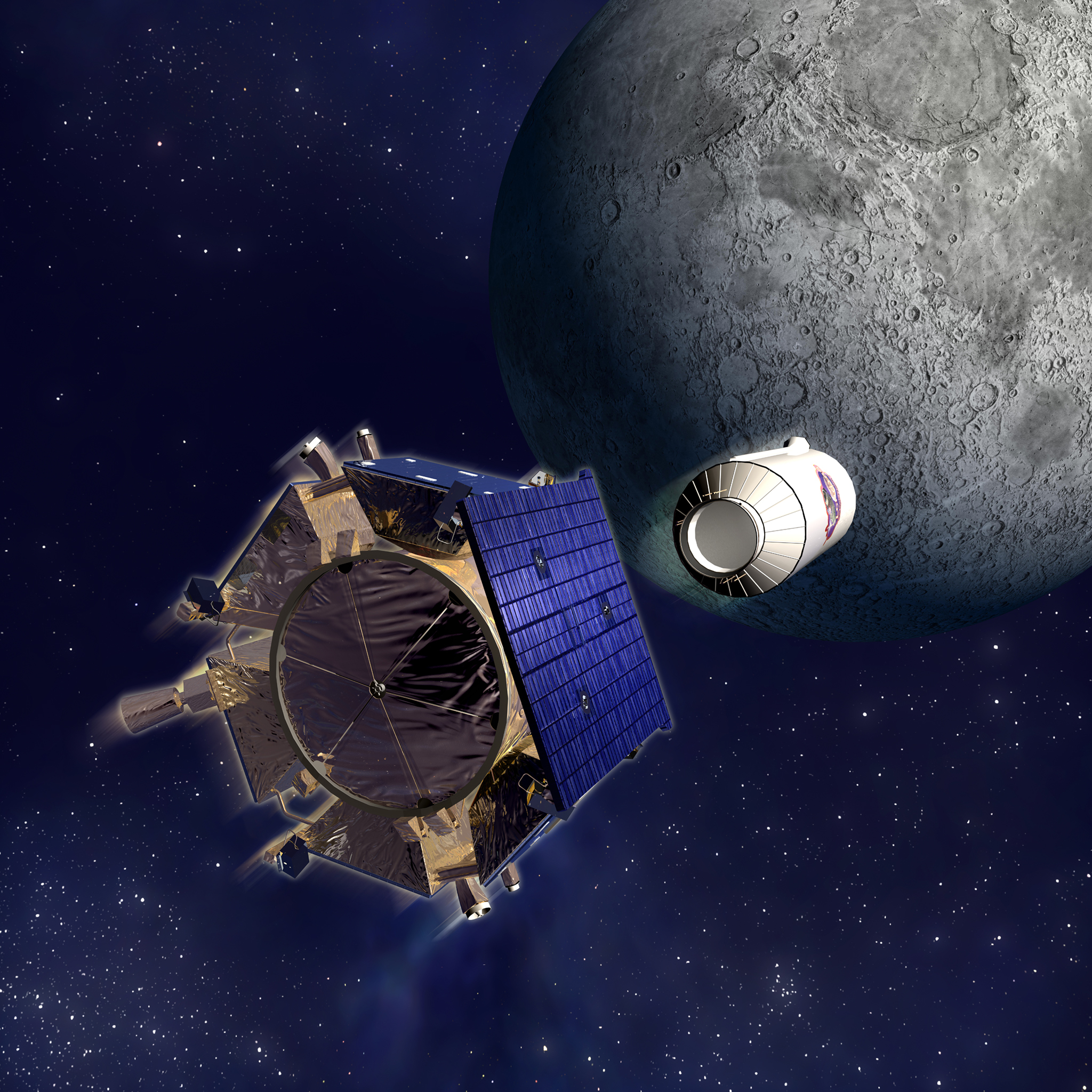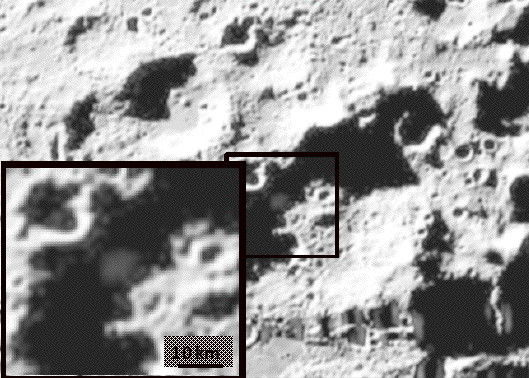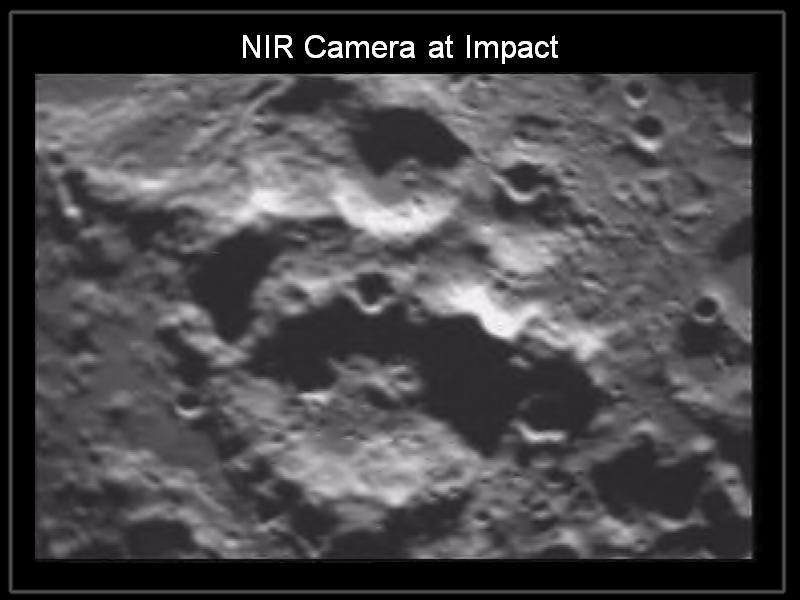Smashing into the Moon for science, LCROSS found water ice in a dark, cold lunar crater.
In the late 1990s, scientists studying the Moon had their appetites whet by the possibility that the Moon might, in fact, be wet. The orbiting spacecraft Lunar Prospector had sensed large amounts of hydrogen at the Moon’s poles. Could this hydrogen be in the form of water molecules – H2O? NASA would have to send a spacecraft that would really get its hands dirty and find out.
In the span of just two years, NASA’s Ames Research Center, in California’s Silicon Valley, developed a mission that reached out and touched the hydrogen detected on the Moon. It was called LCROSS, the Lunar Crater Observation and Sensing Satellite. Their clever design involved two parts: a projectile that would slam into a crater to kick up a giant plume of debris and a spacecraft that would fly through the plume to identify what it was made of.
That crater contained material that may not have seen direct sunlight for billions of years. Because the Moon has very little tilt on its axis, the Sun never shines on the bottom of some craters at the poles. Never rising above negative 280 degrees Fahrenheit, these permanently shadowed craters trap material, like water ice, that might otherwise have “burned off” in the Sun.
The projectile in this story was a just over 40-foot-long section of the rocket that had lifted LCROSS off the Earth and into space. Normally, what amounts to an empty fuel tank is abandoned once a spacecraft has passed through the atmosphere, but LCROSS held on to it during its flight to the Moon, repurposing it in the name of science. The LCROSS team knew this upcycling idea could work, thanks to testing done at the Ames Vertical Gun Range, a unique NASA facility used to simulate high-speed impacts of celestial bodies on a small scale.
In the early morning hours of October 9, 2009, the moment of truth arrived: LCROSS released its used-up rocket, sending it almost straight down into Cabeus crater, near the Moon’s south pole.
As the debris cloud rose above the crater’s rim and was exposed to sunlight, any water ice and other molecules of interest were vaporized and broken down into their basic components. The cameras and other instruments on board LCROSS could then see what this lunar crater soil was made of.
Four minutes was all the time the LCROSS spacecraft had to fly through the lunar dust, soil and other debris lifted into the air by the empty rocket’s impact. In real time, LCROSS streamed images and other data back to Earth, where the mission’s scientists were watching at NASA Ames.
Meanwhile, in orbit around the Moon, NASA’s Lunar Reconnaissance Orbiter, or LRO, had just flown past the impact site when it occurred. When LCROSS itself hit the surface, adding to the plume of surface material, it left the orbiting LRO to continue studying the scene unfolding below.
Buckets of Water: The LCROSS Results
The LCROSS data showed that the lunar soil within shadowy craters is rich in useful materials, such as hydrogen gas, ammonia and methane, which could be used to produce fuel for space missions. Large amounts of light metals, such as sodium, mercury and silver, were discovered. And, as for that hydrogen found at the lunar poles: It does, indeed, belong to crystals of water ice!
That settled it: there is water on the Moon – perhaps as much as hundreds of millions of tons of frozen water, enough to make it an effective oasis for explorers venturing away from Earth. This was a major discovery by LCROSS, and it caused a real change in thinking about the Moon. No longer just a dry, dusty rock, this place holds a vital resource for human space exploration in its accessible crust. That ice represents fuel, water and air that future surface facilities could harvest from the soil to support exploration – instead of bringing it all from Earth.
Questions prompted by the LCROSS results – Where did the water come from? How does the lunar surface change over time? – would be answered by the next mission to the Moon led by NASA Ames. The 2013 Lunar Atmosphere and Dust Environment Explorer, or LADEE, gathered information about the Moon’s atmosphere and dust that will be essential to inform the designs and safety of the next surface missions.
The Spacecraft and Science Instruments
During the LCROSS mission’s more than 120 days, the spacecraft shepherded its empty rocket stage to the Moon. This long journey allowed time to ensure it was empty of any water it may still have been carrying in its batteries or fuel tanks. This time also allowed the Lunar Reconnaissance Orbiter to map the hydrogen at the Moon’s poles using the latest technology to provide the best and most up-to-date information on where LCROSS should to aim.
LCROSS carried nine science instruments to help identify the nature of all that hydrogen. They were selected to provide mission scientists with multiple complementary views of the debris plume created by the surface impact and gather information on lunar crater formation.
There were:
– Two near-infrared spectrometers and an ultraviolet/visible-light spectrometer
Spectrometers examine light emitted or absorbed by materials to help identify their composition. As the debris from the impact rose above the crater’s rim and was vaporized by the sunlight, the spectrometers for visible and infrared light monitored its component parts.
– Two mid-infrared cameras and two near-infrared cameras
These cameras determined the total amount and distribution of water in the debris plume. The mid-infrared cameras also measured the heat signal from the new crater created by the impact.
– A visible-light camera
The spacecraft’s camera using ordinary visible light tracked the impact location and the shape and changes in the debris plume when illuminated by sunlight.
– A high-speed, visible-light photometer
This instrument was designed to measure the initial flash of light created by the impact of the rocket upper stage that was predicted to last less than a second. This flash told us about the initial energy of the impact.
Milestones:
– June 18, 2009: LCROSS launches, along with the Lunar Reconnaissance Orbiter spacecraft, on an Atlas V rocket from Cape Canaveral Air Force Station in Florida.
– Oct. 9, 2009: The mission’s impactor and primary spacecraft impact the lunar surface in the permanently shadowed region of Cabeus crater, near the Moon’s south pole.
– Nov. 13, 2009: NASA announces preliminary results from the LCROSS mission, confirming the discovery of water during the lunar impacts a month earlier.
Partners:
NASA’s Ames Research Center, in California’s Silicon Valley, led the development of the LCROSS mission with its spacecraft and integration partner, Northrop Grumman, in Redondo Beach, California. LCROSS was a fast-paced, low-cost, mission that leveraged some existing NASA systems, commercial off-the-shelf components, the spacecraft expertise of Northrop Grumman and experience gained during the Lunar Prospector mission in 1999. Ames managed the mission, conducting mission operations and developing the payload instruments, while Northrop Grumman designed and built the spacecraft for this innovative mission. Ames’ mission scientists spearheaded the data analysis.
Learn more:
– NASA in Silicon Valley Live – Robotic Exploration of the Moon (video episode, October 2018)
– NASA Missions Uncover the Moon’s Buried Treasures (NASA story, October 2010)
– LCROSS Impact Data Indicates Water on Moon (NASA story, November 2009)
– LCROSS Science Briefing November 13th 2009 (Video of the NASA news conference announcing early science results from the LCROSS mission)
For researchers:
– LCROSS on the NASA Science – Solar System Exploration pages
– LCROSS in the NASA Space Science Data Coordinated Archive
– Images from the LCROSS preliminary impact results
– Detection of Water in the LCROSS Ejecta Plume (research article in the journal Science, October 2010)
For news media:
Members of the news media interested in covering this topic should get in touch with the science representative on the NASA Ames media contacts page.





























